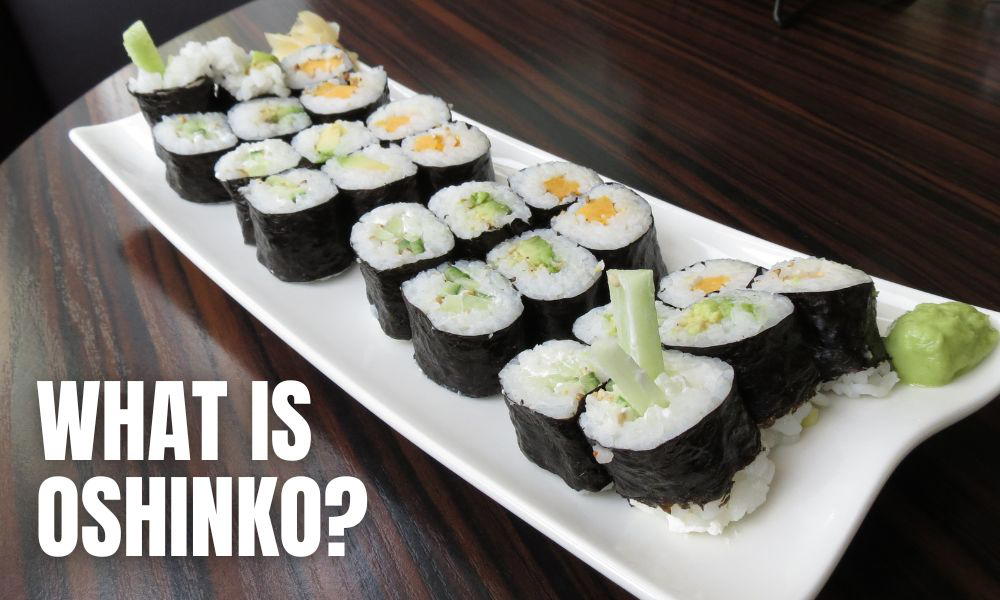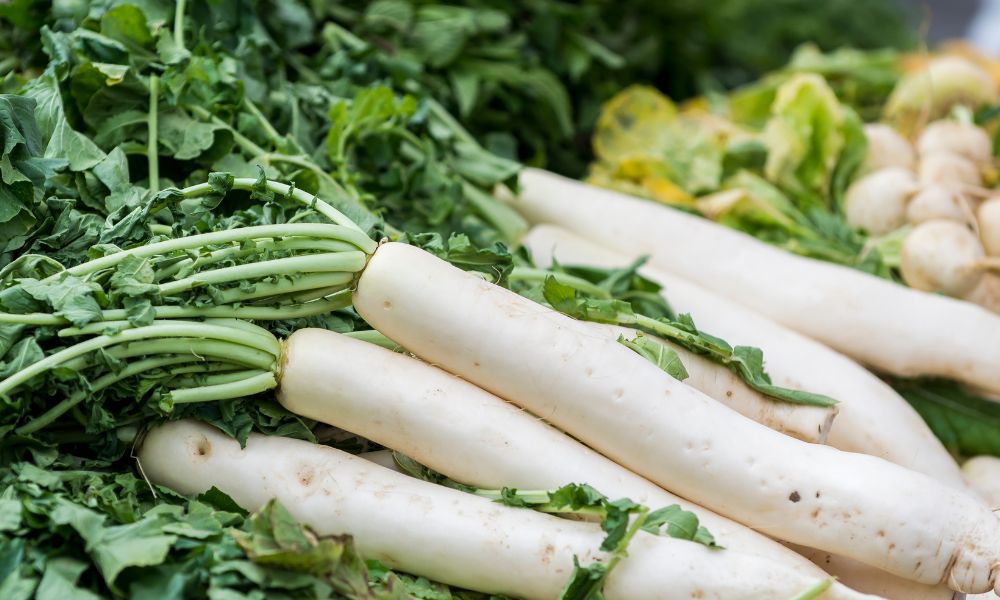Learn what is oshinko, how to make it at home, what are the ingredients, and the recipe for making an oshinko maki for an unforgettable Japanese food experience.

Are you tired of looking for a sushi roll that does not have any fish, meat, and tons of vegetables but still gives a burst of flavors and tastes to tantalize your senses? Look no further! Enter oshinko – somewhat of a hidden gem in the world of sushi rolls. Being both vegan and gluten-free in its original form, anyone can have an oshinko roll made from Japanese pickled vegetables, nori, and sushi rice.
If you’re making the Japanese pickled daikon radish at home, you have full control over what goes into it. But if you’re out to dine in a Japanese restaurant, it’s better to ask if there are any ingredients that are not vegan or gluten-free. Let’s find out all about oshinko, how to make it at home, and a simple oshinko roll recipe.
What Is Oshinko?

Oshinko is a pickled daikon radish from Japan that is popular worldwide. Oshinko is Japanese for “fresh” and “flavored.” And that accurately describes oshinko, which is flavorful and fresh. These pickles were created by a Buddhist priest named Takuan in the 17th century, who also introduced them to Japan. Takuan needs to ferment for months and the process is quite smelly. Consequently, they are usually bought from the store.
Takuan is produced just once a year. Daikon is picked in the fall and left to dry for two to three weeks in the shade. Then they undergo a brief period of pickling in salt. Then follows a two- to three-month fermentation process with additional salt and rice bran (nuka). The takuan can keep for up to a year after fermentation. It is frequently served with hot rice. And many pickles frequently contain takuan as an ingredient.
Japanese oshinko refers specifically to daikon radish while tsukemono can include other types of pickled vegetables like cabbage and cucumber. Oshinko is pickled in vinegar for a shorter time than other tsukemono and has less sea salt.
Fun Fact: All oshinko is tsukemono but not all tsukemono are not oshinko.
What Is Daikon Radish?

The root vegetable daikon, also known as winter radish, is long and tubular, much like a carrot. Daikon radishes are mild in flavor, slightly sweet, and have a crunchy texture. They typically have white bodies with green tops, but they can also be any number of colors and shapes. Although daikon and radishes belong to the same family, they differ in a few ways. Compared to the radishes used in Japanese cuisine, red radishes are much smaller, spicy, and have a stronger flavor. White radishes are mellow and mildly sweet.
Oshinko: How To Make Oshinko In 3 Steps

To make sushi pickled radish or oshinko, you need some basic ingredients and follow 3 simple steps. The ingredients are:
1 pound or 450 grams of daikon radish
2 tablespoons of vinegar
⅔ cup sugar
1 tablespoon salt
To make oshinko, follow the steps below:
01 Peel and cut the daikon into thin strips.
02 In a large jar or container, put the daikon radish strips and add the vinegar, salt, and sugar.
03 Place the jar in the refrigerator for two to three days with a tight seal. Oshinko will stay good in the refrigerator for up to one month.
Pro Tip: For a more pungent result, you can ferment the oshinko for two to three weeks.
What Does Oshinko Taste Like?

Oshinko is a combination of sweet, salty, and sour as it’s made from radish or daikon which is soaked in a solution of sea salt, sugar, and vinegar. The umami or salty flavor of the oshinko comes from sea salt and is balanced by the sweetness from the daikon or horse radish and sugar. Daikon’s flavor is milder than that of other varieties of radishes. When cooked, daikon takes on a taste very similar to potatoes and has a soft texture.
What Is Oshinko Roll?
Oshinko is produced from pickled daikon radish and because the flavors are so packed, you wouldn’t find any restaurant offering an oshinko salad. The best way to relish it is through an oshinko roll or oshinko maki. This is one of the main sushi types and if you are trying to guess what is oshinko in sushi, well, it’s pickled radish, sushi rice, and nori seaweed as the wrapper. Sake and red chili pepper are also added sometimes.
How To Make Oshinko Maki Roll
A vegan and vegetarian sushi option, it’s not only easy to make a daikon sushi roll but it also has the right crunch and the sweet and sour taste that can add a new layer of flavor and texture to your regular meal. Here is a simple oshinko roll recipe.
Oshinko Roll Ingredients
There are three parts to making pickled radish roll sushi – preparing the sushi rice, assembling the oshinko roll, and serving it with a dipping sauce. So, I will cover each of these parts one by one so that you don’t miss out on any ingredients. Before I forget, let me share with you that a bamboo mat like this for rolling the oshinko sushi roll is necessary so have one at hand before you start making the oshinko roll.
Sushi Rice Ingredients
1 cup of Japanese short-grain sushi rice. Pick any from the 10 best sushi rice brands for the best quality
1 cup of water
1½ tablespoons of sushi vinegar like this or if you want to make your own, simply mix 2 tablespoons of rice vinegar with 1 teaspoon of salt and 1 tablespoon of sugar.
Oshinko Sushi Roll Ingredients
10 ounces of yellow pickled radish (see recipe above on how to make oshinko)
4 sheets of nori seaweed like this
Serving Or Topping
Wasabi paste like this
Soy sauce
Steps To Make Oshinko Roll Sushi
There are basically three steps to making oshinko maki rolls – preparing the sushi rice, making the oshinko, and assembling the sushi roll. Let’s cover each of these steps in detail so that you will be a pro at making pickled daikon radish rolls.
Step 1: Prepare The Sushi Rice
Keep the prepared sushi vinegar ready as you will need it soon after you’re done cooking the sushi rice. You can use either a rice cooker to make sushi rice or cook it on the stovetop. Take a strainer and put the rice in it. Now run it under cold tap water to remove the extra starch. As you wash the rice, move your hand through the grains to ensure that all the starch floats to the top and drains out. Repeat this until the water is clear.
Add the rice to a big saucepan or cooker and give the rice 30 minutes to soak in the water. Make sure how your rice cooker functions by reading the product manual because some rice cookers have a soaking cycle included in the overall cooking cycle. If cooking on the stovetop, cover the lid and turn the flame on high until the water boils. Then lower the flame and allow the rice to cook for 15 minutes. After all the water has been absorbed by the rice, turn off the stove and keep the lid on for 10 more minutes to allow the rice to steam properly.
After the rice is steamed, put it on a large platter and allow it to cool slightly. Then add the sushi vinegar mixture to the warm rice carefully so that you don’t break the rice grains.
Step 2: Making The Oshinko
Make the oshinko as described above. Then cut the yellow pickled radish into long strips using a sharp knife, each about ¼-inch thick.
Step 3: Assembling The oshinko Roll
This is where you need the bamboo mat to make the oshinko sushi rolls the right way. I tried once without it and trust me, it doesn’t roll the same way and the results can be very disappointing.
If you don’t want a big, fat oshinko roll, cut ¼ of the nori sheet and lay it on a plastic wrap placed over the bamboo mat.
💡Pro Tip: Worried about how to keep nori from getting soggy? You just need to refrigerate it in its original packaging until you’re ready to use it.
The plastic sheet helps to keep the bamboo mat clean and makes the process mess-free. You will notice that one side of the seaweed or nori sheet is shiny. Always place this shiny side face down on the bamboo mat. Now spread the prepared sushi rice evenly on the nori sheet. Take care to leave ½-inch of space at the top of the mat as you wouldn’t want the sushi rice and its fillings spilling out of the oshinko roll when you roll it tightly.
Next, put the pickled radish strips or other Japanese pickled vegetables on the rice so that they cover the rice horizontally from one end to another. Then put your thumbs under the bamboo sushi mat, lift the edges up, and cover the filling. While you roll the mat away from you, keep pressing the sushi rice and fillings until you have reached the end of the mat. You can dip your hands in water or a solution made from 2 teaspoons of rice vinegar and ¼ cup of water so that the rice doesn’t stick to your hands.
Serve with a side of wasabi paste and soy sauce.
If you want, you can use the whole big seaweed sheet to make a large oshinko roll and then cut it up into smaller pieces.
7 Tips To Make And Use Oshinko
01 Pick daikon radish with smooth skin.
02 The radish needs to be fresh.
03 Add turmeric or saffron to the pickling liquid if you want the oshinko to be yellow.
04 Instead of using oshinko as the single filling in an oshinko maki roll, use it in other types of sushi like futomaki or uramaki along with other fillings.
05 Use oshinko as a palate cleanser and serve with rice, poke bowls, and miso soup.
06 For a pretty garnish over an oshinko poke, use oshinko.
07 Oshinko food can also be used as a condiment to balance the saltiness of a dish.
FAQs
What Is Oshinko Made Of?
Oshinko is made of daikon radish, vinegar, sugar, and salt.
Is Oshinko Good For You?
If you are wondering is oshinko healthy for you, yes it is. Oshinko has few calories but a lot of fiber. The vegetable itself also contains Vitamin C, which strengthens the immune system. Additionally, the pickling process generates a number of beneficial enzymes that aid in digestion and have anticancer properties.
Is Oshinko Spicy?
Oshinko roll is not spicy if it’s made from daikon radish which is slightly sweet to taste.
Why Is Oshinko Yellow?
When dried gardenia fruit is added to the daikon, the oshinko turns yellow. This is the traditional way of making the oshinko yellow. Modern methods include adding yellow food coloring, turmeric powder, or saffron to the vinegar, salt, and sugar solution.